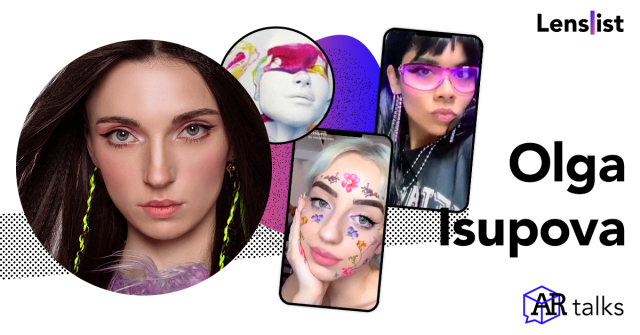AR talks | Olga Isupova aka visualizee.me

Olga Isupova, widely known as Visualizee.me, is an incredibly popular Instagram AR artist who was named by @facebookcurated the forefront of digital reneissance. She told us about her artistic style, collaborating on AR filters and her view on the future of virtual fashion.
Hi Olga! First of all, please tell us something about yourself. What had you been doing before Spark AR and how did it happen that you’ve started on that road?
Hi, Lenslist! I am happy to answer your questions!
My way to digital art was not easy for me, because I had to stop all my offline projects (such as painting, drawing and perfecting my drawing technique). But now I understand that this background is reflected in my projects. My classic art education helps me to find the method how to work with light or shadows on the scene, separate foreground and background or get closer to reality with AR objects. As a result, I can create more realistic content.
I think nothing changes and every creator needs to explore the nature. The ideas can be extremely fantastic, but it is important to understand how to interpret them properly.
We appreciate that you often share on what inspires you while making filters. We’ve read about expressive art of Henri Rousseau, kawaii Japanese culture or your own reflections about reality. Could you tell us more about the style of yours and what are your biggest influences? What drives you to make the next filter?
I feel inspired every day. I can draw inspiration from diversity of people’s faces, graceful movements of animals, tenderness of flowers and force energy of trees. Also, the ideas appear when I look at the paintings. My favorite periods are the Renaissance and Ancient Greece. I consider these periods to be an unattainable ideal for all the artists. Anyway, any artist gets ideas from already existing art objects even if he or she is not aware of it. In the era of metamodernism each and every work of art is based on quotations and connections with pieces of art of past eras. That’s why it’s important to fill your works with iconographic images.
A collaborative working is becoming more and more popular among AR creators. Could you tell us more about your cooperations, eg. with @trashymuse? Why the community is so important for the creative process of Instagram filters?
I think that cooperation with artists is extremely important for mutual influence and getting new energy. I’m working with @filtermuse and @trashymuse because their perception of AR reality and its prospects for the future relates to me. Despite having different styles, we have been collaborating for two years. Also, I really appreciate contact with other developers and I would like carry out more collaborations in the near future.
The active expansion of the platform is happening now. So, I think that every creator will be valuable for his or her vision and style. Most likely, this is even more important than technical skills, as it determines recognition, personality and originality of the creator.
When describing your 2000s aesthetics filter, you stated that AR beauty accessories are the future of fashion. Of course, that’s an awesome vision and many will agree with you, but isn’t it just far away from becoming a reality? How do you think it will happen?
I think that it’s a matter of commerce, mostly. It all depends on whether brands want to create high-quality free content for their users or not. The main advantage of AR accessories, clothes and shoes is that they are eco-friendly. We use only electricity for creation of the filter, server space and our own time. On the one hand, all these things are not physical and, as a result, more ethical. But, from the other hand, it leads to total democratization of fashion industry.
When creating my filters with accessories, I wanted to achieve hyper-realism – ultimate fusion of objects, faces and environment. In a sense, this has become a disadvantage for my filters because users don’t understand that accessories exist in AR while watching the video. Anyway, I’m happy with the result so far and I want to continue my experiments as soon as the tracker for arms, legs and the whole body appears.
We couldn’t resist asking you this: how did it feel like when Bella Hadid had used your filter?
Of course, it was a shock, in a way.
At last, do you have any tips for AR beginners when it comes to creating filters or working with clients?
When working on your filters, it is important to have a clear message for users, as well as to imagine your final result, at least in general terms. In order to achieve high quality of your works and become better every day you have to constantly develop your aesthetic taste (and it’s not only about scrolling through Instagram, lol). During your work with clients you need to understand their needs and, perhaps, to some extent adjust your style to their requirements. You also have to be patient. Each brand has its own values and you should reflect these values in your filter.
Olga, thank you very much for your time and insightful remarks on AR considering art and commerce. Keep up the good work!
